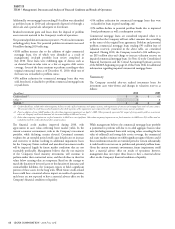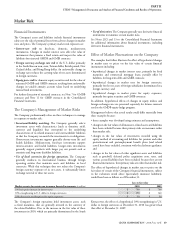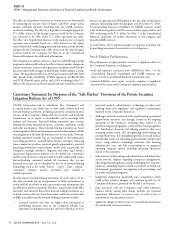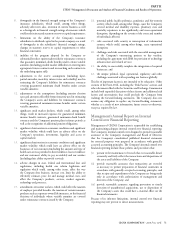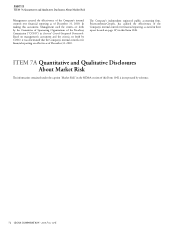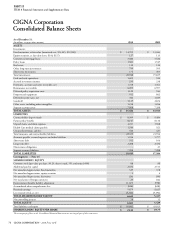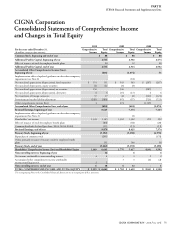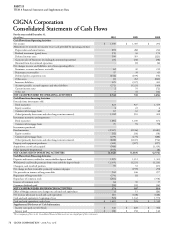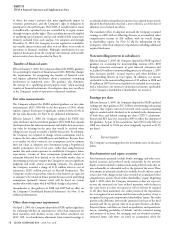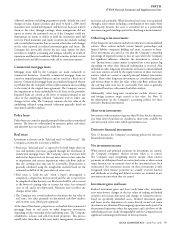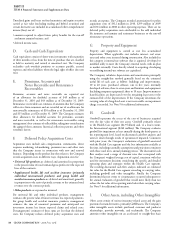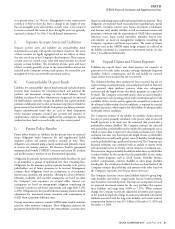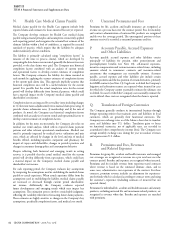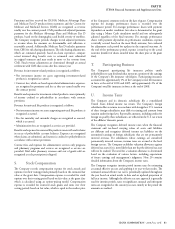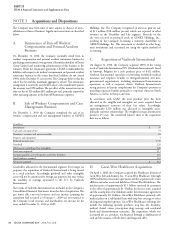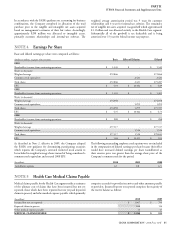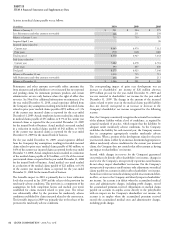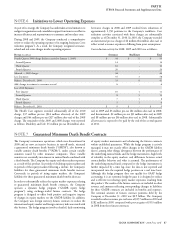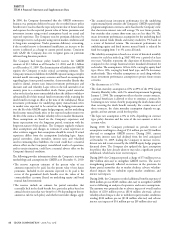Cigna 2010 Annual Report Download - page 98
Download and view the complete annual report
Please find page 98 of the 2010 Cigna annual report below. You can navigate through the pages in the report by either clicking on the pages listed below, or by using the keyword search tool below to find specific information within the annual report.CIGNA CORPORATION 2010 Form 10K
78
PART II
ITEM 8 Financial Statements and Supplementary Data
to direct the entity’s activities that most signifi cantly impact its
economic performance, and the Company’s right or obligation to
participate in that performance (ASC 810). A variable interest entity
is insuffi ciently capitalized or is not controlled by its equity owners
through voting or similar rights. ese amendments must be applied
to qualifying special-purpose entities and troubled debt restructures
formerly excluded from such analysis. On adoption and through
December 31, 2010, the Company was not required to consolidate
any variable interest entities and there were no eff ects to its results of
operations or fi nancial condition. Although consolidation was not
required, disclosures about the Company’s involvement with variable
interest entities have been provided in Note 14.
Transfers of fi nancial assets
Eff ective January 1, 2010, the Company adopted the FASB’s guidance
for accounting for transfers of fi nancial assets (ASC 860) that changes
the requirements for recognizing the transfer of fi nancial assets
and requires additional disclosures about a transferor’s continuing
involvement in transferred assets. e guidance also eliminates
the concept of a “qualifying special purpose entity” when assessing
transfers of fi nancial instruments. On adoption, there were no eff ects
to the Company’s results of operations or fi nancial condition.
Fair value measurements
e Company adopted the FASB’s updated guidance on fair value
measurements (ASU 2010-06) in the fi rst quarter of 2010, which
requires separate disclosures of signifi cant transfers between levels in
the fair value hierarchy. See Note 11 for additional information.
Eff ective January 1, 2008, the Company adopted the FASB’s fair
value disclosure and measurement guidance (ASC 820) that expands
disclosures about fair value measurements and clarifi es how to measure
fair value by focusing on the price that would be received when
selling an asset or paid to transfer a liability (exit price). At adoption,
the Company was required to change certain assumptions used to
estimate the fair values of GMIB assets and liabilities. Because there
is no market for these contracts, the assumptions used to estimate
their fair values at adoption were determined using a hypothetical
market participant’s view of exit price, rather than using historical
market data and actual experience to establish the Company’s future
expectations. Certain of these assumptions (primarily related to
annuitant behavior) have limited or no observable market data so
determining an exit price requires the Company to exercise signifi cant
judgment and make critical accounting estimates. On adoption,
the Company recorded a charge of $131 million after-tax, net of
reinsurance ($202 million pre-tax), in Run-off Reinsurance. e
Company’s results of operations related to this business are expected
to continue to be volatile in future periods because several underlying
assumptions (primarily interest rates) will be based on current
market-observable inputs which will likely change each period.
Amendments to this guidance in 2008 and 2009 had no eff ect on
the Company’s Consolidated Financial Statements. See Note 11 for
additional information.
Other-than-temporary impairments
On April 1, 2009, the Company adopted the FASB’s updated guidance
for evaluating whether an impairment is other than temporary for
fi xed maturities with declines in fair value below amortized cost
(ASC 320). A reclassifi cation adjustment from retained earnings to
accumulated other comprehensive income was required for previously
impaired fi xed maturities that had a non-credit loss as of the date of
adoption, net of related tax eff ects.
e cumulative eff ect of adoption increased the Company’s retained
earnings in 2009 with an off setting decrease to accumulated other
comprehensive income of $18 million, with no overall change
to shareholders’ equity. See Note 12 (A) for information on the
Company’s other-than-temporary impairments including additional
required disclosures.
Noncontrolling interests in subsidiaries
Eff ective January 1, 2009, the Company adopted the FASB’s updated
guidance on accounting for noncontrolling interests (ASC 810)
through retroactive restatement of prior fi nancial statements and
reclassifi ed $3 million of noncontrolling interest as of January 1, 2007
from Accounts payable, accrued expenses and other liabilities to
Noncontrolling interest in total equity. In addition, net income
attributable to the noncontrolling interest of $2 million in 2008 and
$3 million in 2007 has been reclassifi ed to be included in net income,
with a reduction to net income to determine net income attributable
to the Company’s shareholders (“shareholders’ net income”).
Earnings per share
Eff ective January 1, 2009, the Company adopted the FASB’s updated
earnings per share guidance (ASC 260) for determining participating
securities that requires unvested restricted stock awards containing
rights to nonforfeitable dividends to be included in the denominator
of both basic and diluted earnings per share (“EPS”) calculations.
Prior period EPS data were restated in 2009 to refl ect the adoption of
this guidance. As part of this restatement, basic EPS for the full year
2008 was adjusted to $1.04 per share (originally reported as $1.05
per share).
C. Investments
e Company’s accounting policies for investment assets are discussed
below:
Fixed maturities and equity securities
Fixed maturities primarily include bonds, mortgage and other asset-
backed securities and preferred stocks redeemable by the investor.
Equity securities include common stocks and preferred stocks that are
non-redeemable or redeemable only at the option of the issuer. ese
investments are primarily classifi ed as available for sale and are carried
at fair value with changes in fair value recorded in accumulated other
comprehensive income (loss) within shareholders’ equity. Beginning
April 1, 2009, when the Company determines it does not expect to
recover the amortized cost basis of fi xed maturities with declines in
fair value (even if it does not intend to sell or will not be required
to sell these fi xed maturities), the credit portion of the impairment
loss is recognized in net income and the non-credit portion, if any, is
recognized in a separate component of shareholders’ equity. e credit
portion is the diff erence between the amortized cost basis of the fi xed
maturity and the net present value of its projected future cash fl ows.
Projected future cash fl ows are based on qualitative and quantitative
factors, including probability of default, and the estimated timing
and amount of recovery. For mortgage and asset-backed securities,
estimated future cash fl ows are based on assumptions about the


